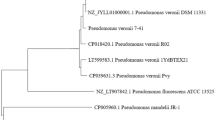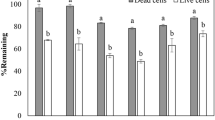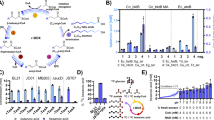Abstract
LARGE amounts of novel organic compounds are released into the environment by the rapidly growing chemical industry. The main agents for returning natural and, presumably, synthetic organic compounds to the carbon cycle are bacteria and fungi, provided that catabolic enzymes with appropriate specificities, transport systems and regulatory mechanisms can be activated. One or several of these conditions for total degradation do not seem to be fulfilled for certain types of man-made compounds, in particular, the halogenated aromatic hydrocarbons. In this report, we demonstrate the transfer of the TOL plasmid from Pseudomonas putida mt-2 (WR 101) to Pseudomonas sp. B13 (WR 1) enabling novel strains to be isolated which can utilize various chlorosubstituted benzoates as their sole source of carbon and energy.
This is a preview of subscription content, access via your institution
Access options
Subscribe to this journal
Receive 51 print issues and online access
$199.00 per year
only $3.90 per issue
Buy this article
- Purchase on Springer Link
- Instant access to full article PDF
Prices may be subject to local taxes which are calculated during checkout
Similar content being viewed by others
References
Dorn, E. et al. Archs Microbiol. 99, 61–70 (1974).
Knackmuss, H.-J. & Hellwig, M. Archs Microbiol. 117, 1–7 (1978).
Reineke, W. & Knackmuss, H.-J. Biochim. biophys. Acta 542, 412–423 (1978).
Reineke, W. & Knackmuss, H.-J. Biochim. biophys. Acta 542, 424–429 (1978).
Dorn, E. & Knackmuss, H.-J. Biochem. J. 174, 85–94 (1978).
Williams, P. A. & Murray, K. J. Bact. 120, 416–423 (1974).
Wong, C. L. & Dunn, N. W. Genet. Res. 23, 227–232 (1974).
Wu, T. T. et al. J. Bact. 96, 447–456 (1971).
Oliver, E. J. & Mortlock, R. P. J. Bact. 108, 293–299 (1971).
Betz, J. L. et al. Nature 247, 261–264 (1974).
Senior, E. et al. Nature 263, 476–479 (1976).
Wood, W. A. A. Rev. Biochem. 35, 521–558 (1966).
Le Blanc, D. J. & Mortlock, R. P. J. Bact. 106, 90–96 (1971).
Rigby, P. W. J. et al. Nature 251, 200–204 (1974).
Chakrabarty, A. M. A. Rev. Genet. 10, 7–30 (1976).
Pemberton, J. M. & Fisher, P. R. Nature 268, 732–733 (1977).
Author information
Authors and Affiliations
Rights and permissions
About this article
Cite this article
REINEKE, W., KNACKMUSS, HJ. Construction of haloaromatics utilising bacteria. Nature 277, 385–386 (1979). https://doi.org/10.1038/277385a0
Received:
Accepted:
Issue Date:
DOI: https://doi.org/10.1038/277385a0
This article is cited by
-
Aerobic degradation of polychlorinated biphenyls
Applied Microbiology and Biotechnology (2005)
Comments
By submitting a comment you agree to abide by our Terms and Community Guidelines. If you find something abusive or that does not comply with our terms or guidelines please flag it as inappropriate.



